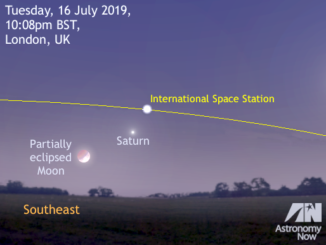
Large enough to swallow three planets the size of the Earth, Jupiter’s Great Red Spot (GRS) is the greatest and most persistent anticyclonic storm in the Solar System, having raged in the planet’s atmosphere for at least 400 years. But what gives the GRS its characteristic ruddy colour? The leading theory proposes that it’s due to chemicals upwelling from deeper layers of Jupiter’s atmosphere.
However, this view is now contradicted in results just presented by Cassini team scientist Kevin Baines at the American Astronomical Society’s Division for Planetary Science Meeting in Tucson, Arizona. Baines, with NASA Jet Propulsion Laboratory colleagues Bob Carlson and Tom Momary, now believe the colour is likely a product of simple chemicals being broken apart by sunlight in the planet’s upper atmosphere, basing their conclusions on a new analysis of data from Cassini’s December 2000 Jupiter flyby and laboratory experiments.
Jupiter is composed almost entirely of hydrogen and helium with a scattering of other elements. If scientists can understand what combinations of elements are responsible for the colours seen in Jupiter’s clouds this would provide insights into the giant planet’s make-up. Jupiter possesses three main cloud layers which, from highest to lowest, are ammonia, ammonium hydrosulfide and water clouds.
When the researchers exposed ammonia and acetylene (a molecule also known to exist on Jupiter) to powerful ultraviolet light in an attempt to simulate the Sun’s effects on these chemicals at the extreme heights of clouds in the Great Red Spot, they produced a reddish material which the team compared to the GRS as observed by Cassini’s Visible and Infrared Mapping Spectrometer (VIMS). The laboratory synthesised material had light-scattering properties that matched a GRS model in which the red-coloured material is confined to the uppermost reaches of the giant cyclone-like feature.
“Our models suggest most of the Great Red Spot is actually pretty bland in colour, beneath the upper cloud layer of reddish material,” said Baines. “Under the reddish ‘sunburn’ the clouds are probably whitish or greyish.” A colouring agent confined to the top of the clouds would be inconsistent with the long-help competing theory, which asserts that the spot’s colour is due to upwelling chemicals formed deep beneath the visible cloud layers, he said. If red material were being transported from below then it should also be present at other altitudes too, further reddening the GRS.
Experiments to simulate Sun-induced breakdown of more a complex molecule like ammonium hydrosulfide produced a brilliant shade of green, a surprisingly negative result that prompted the researches to try simple combinations of ammonia with hydrocarbons known to be common at high Jovian altitudes. Breaking down ammonia and acetylene with ultraviolet light turned out to best fit the data collected by Cassini.
If altitude plays a key role, then it explains why the GRS and a few smaller spots on the planet display such colours. “The Great Red Spot is extremely tall,” Baines said. “It reaches much higher altitudes than clouds elsewhere on Jupiter.”
The cyclonic winds of the Red Spot transport ammonia ice particles higher into the atmosphere than usual, where they are exposed to much more of the Sun’s ultraviolet light, hence enabling and enhancing the reddening. In addition, the vortex nature of the spot confines particles, preventing them from escaping, causing the redness of the spot’s cloud tops to increase beyond what might otherwise be expected.
Jupiter displays a mixed palette of oranges, browns and even shades of red. Baines says these are places where high, bright clouds are known to be much thinner, allowing views to depths in the atmosphere where more colourful substances exist.
The Cassini-Huygens mission is a cooperative project of NASA, the European Space Agency and the Italian Space Agency. JPL, a division of the California Institute of Technology, Pasadena, manages the mission for NASA’s Science Mission Directorate in Washington. The VIMS team is based at the University of Arizona in Tucson.
More information about Cassini:
http://www.nasa.gov/cassini
http://saturn.jpl.nasa.gov



